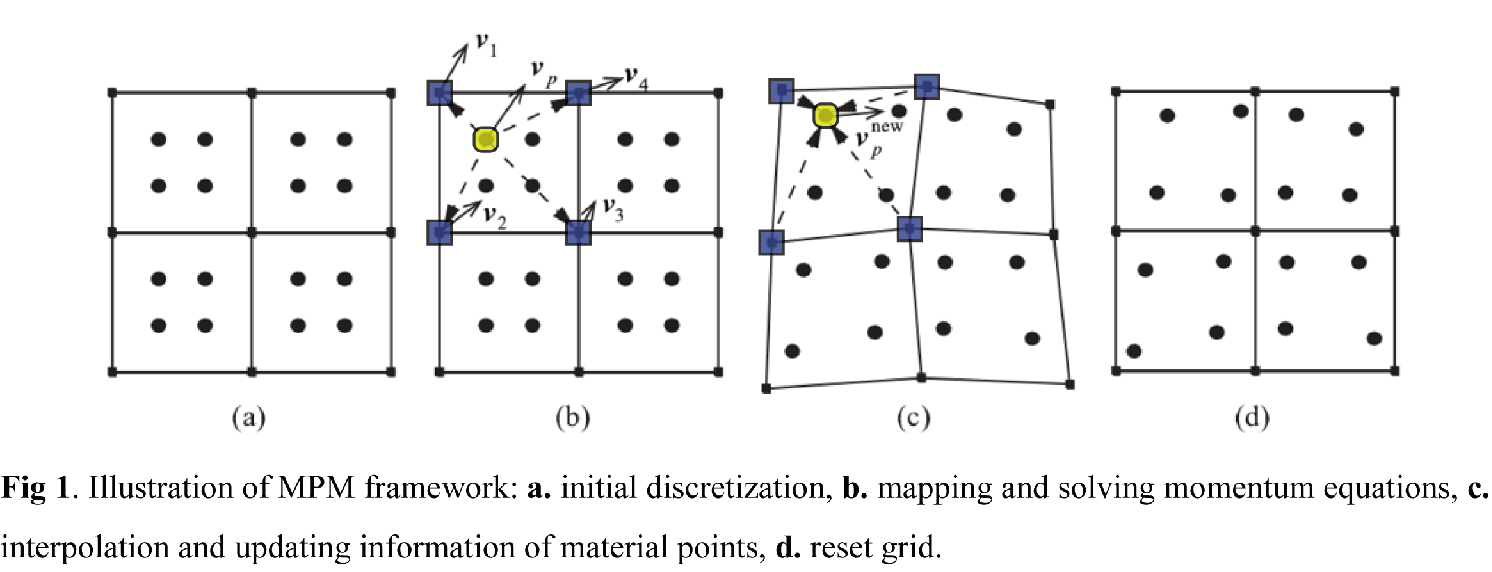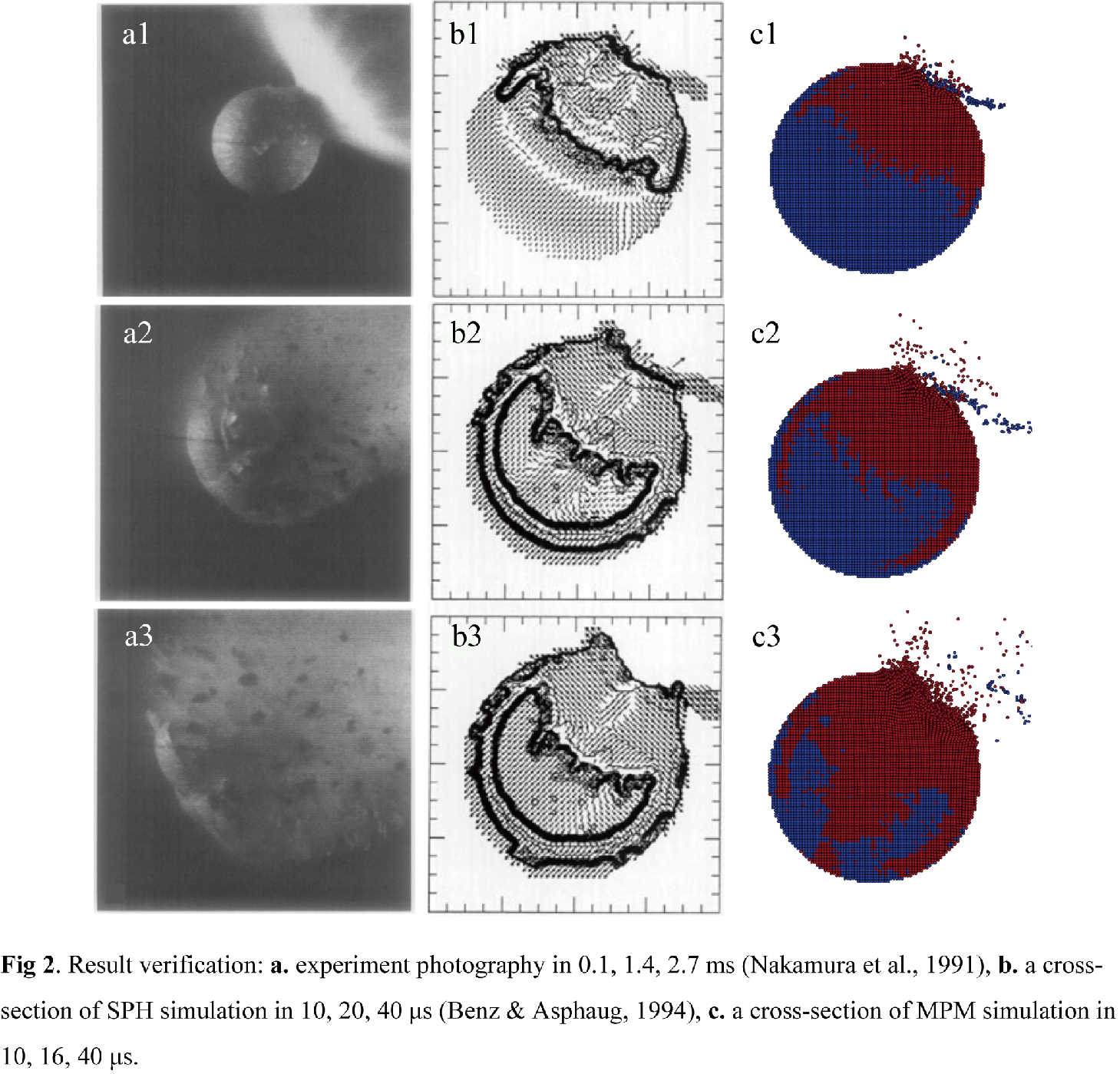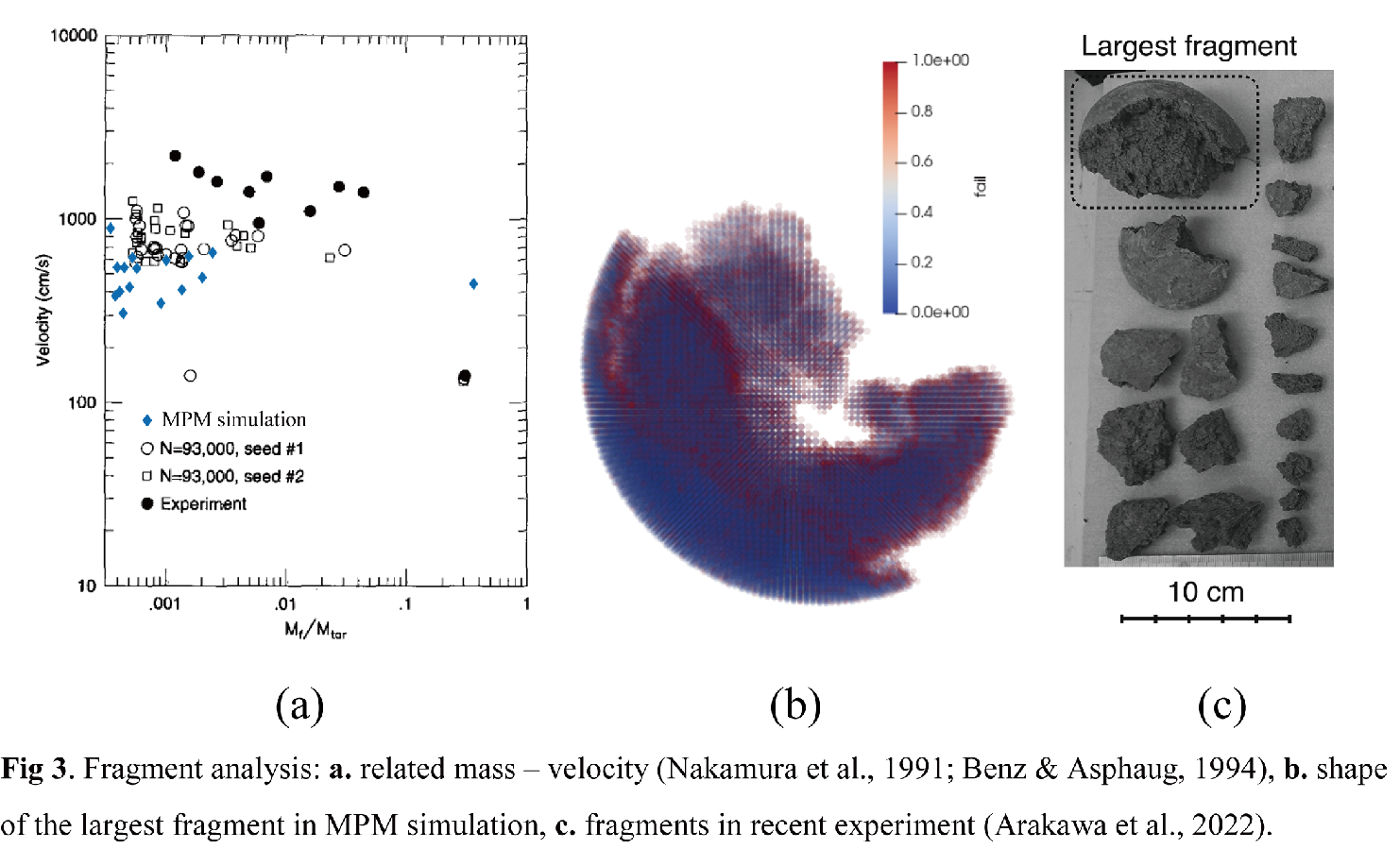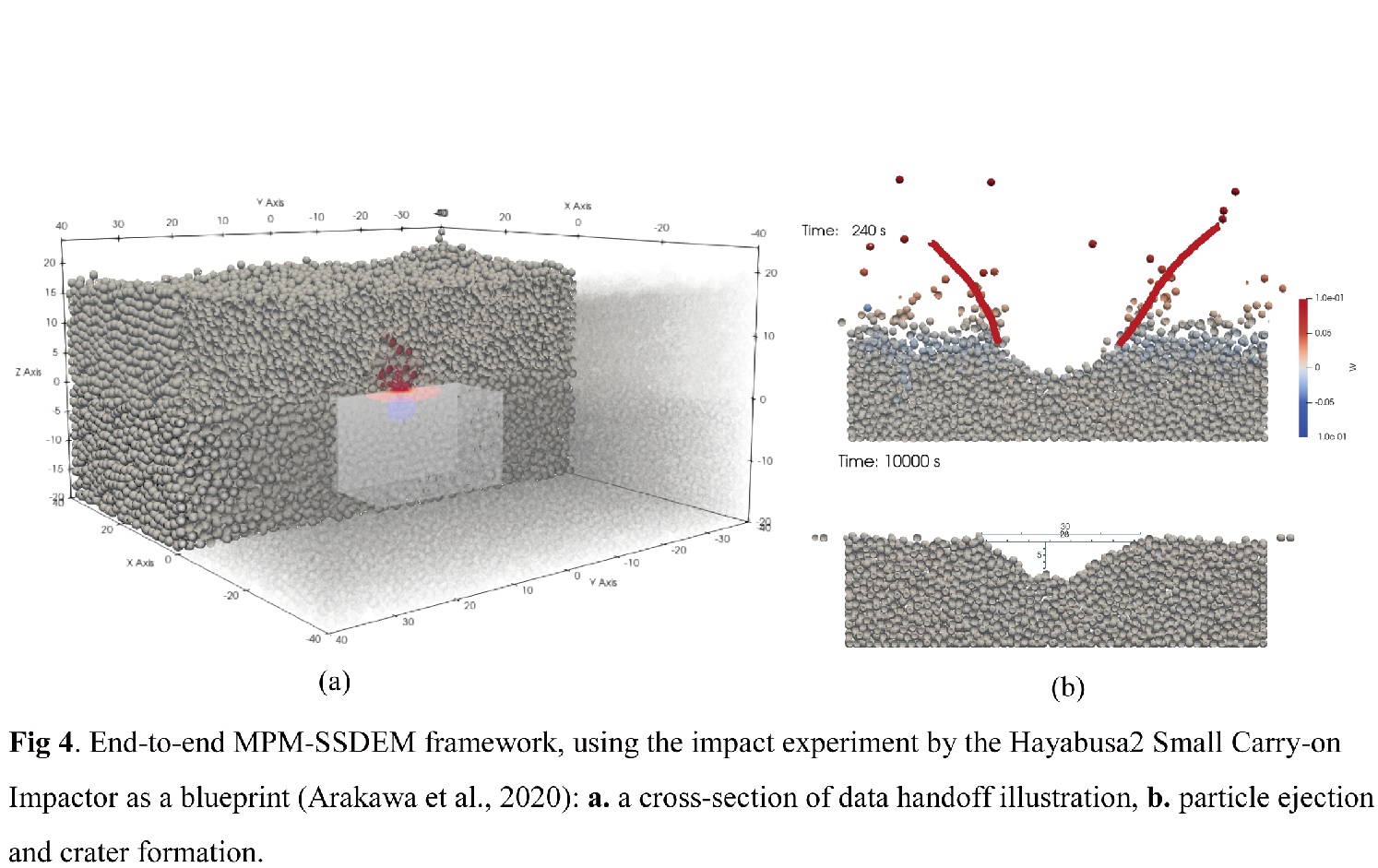Hypervelocity impact simulation on asteroids with MPM framework
- 1School of Aerospace Engineering, Tsinghua University, Beijing 100084, China (yxr17@mails.tsinghua.edu.cn)
- 2Université Côte d’Azur, Observatoire de la Côte d’Azur, CNRS, Laboratoire Lagrange, Nice 06304, France
- 3Department of Aerospace Engineering, University of Maryland, College Park, MD, 20742, USA
1. Introduction
Asteroid impacts, ranging from small-scale cratering events to catastrophic disruption, have played a crucial role in the formation and evolution of asteroids (Jutzi et al., 2015). Thanks to the increasing performance of computers, shock-physics numerical codes have become commonly used in the field of hypervelocity impacts, to extrapolate experimental results and help us be better prepared for space missions devoted to asteroid deflection using the kinetic impactor techniques, such as the NASA DART (Rivkin et al. 2020) and ESA Hera missions (Michel et al. 2022), and evaluate the outcomes.
Past numerical studies showed us that it is possible to divide the asteroid impact process into two stages that occur at very different time scales, the early stage of fragmentation of the asteroid and the late stage of gravitational reaccumulation of the fragments (e.g, Michel et al. 2001). For the early stage, various numerical methods have been developed to solve this short but extreme physical process, such as the Smooth Particle Hydrodynamics (SPH) technique used in codes like the Bern SPH and grid techniques used in codes like CTH or iSALE. Each method has its unique advantages, but they share a common challenge that the contact and the boundary condition are not well handled (El Mir et al., 2019).
In this study, we exploit the Material Point Method (MPM) framework, an extension of the particle-in-cell method, to simulate the early stage of impact in order to offer a new approach and solutions to the above problems.
2. Methods
MPM is a meshfree method, characterizing the material domain by a group of points. These Lagrangian material points carry all state variables. Meanwhile, a predefined regular background grid is used. In each timestep, material information is mapped to grid nodes, to solve the momentum equations, and material points deform with the grid. Then the information is mapped back to the points to update their positions and velocities, discard the deformed grid, and reset a new one to calculate the next timestep (Zhang et al., 2013). MPM framework combines the advantage of both Lagrangian description and Eulerian description, which not only avoids the undesirable mesh tangling caused by large deformations, but also eliminates the difficulties in solving contact and boundary conditions.

As such, MPM is well used in simulating impacts, explosions, and metal forming of on-earth situation (Zhang et al., 2013). So far, it has not been commonly used to model hypervelocity impacts on asteroids (El Mir et al., 2019). Hence, we start with building material models that are applicable to asteroids made of porous and brittle materials.
The material models include Drucker-Prager strength model that describes cohesion and pressure-dependent strength effect. We also use the Tillotson equation of state for basalt coupled with the P-alpha model which accounts for porosity, and as stress-based failure criterion consistent with Weibull distribution. The framework is thus similar to that used by other studies using the SPH numerical method (Raducan and Jutzi, 2021). Our MPM model is then validated by comparing with laboratory impact experiments and the simulations using the SPH method.
3. Results
We compare our simulations with SPH simulations (Benz & Asphaug, 1994) and the impact experiments (Nakamura et al., 1991) on non-porous basalt sphere used to validate them. Our result shows that our material model under the MPM framework can successfully characterize the shell-like propagation of the failure zone (Fig 2.c2). However, a concentration of stresses reflected back from the boundary subsequently occurres, resulting in a severe secondary failure in the nuclear region. (Fig 2.c3) This stress concentration may cause by the unsmooth discrete boundary and the lack of energy dissipation. The analysis of large fragments reveals this problem too: although with a similar mass distribution, the velocity of the largest fragment in MPM simulation is significantly higher (Fig 3.a). Apart from that, the simulation results are otherwise in good agreement with the previous studies, especially the shape of the largest fragment of MPM simulation (Fig 3.b) versus a recent experiment (Fig 3.c). Noting the usual spreading in experimental outcomes using same conditions, the MPM method can thus be considered valid.


Further research will be centered on verifying the P-alpha model and the correct treatment of porosity (Jutzi et al., 2009).
4. Conclusion and Discussion
The MPM framework can complement of other shock-physics code to balance the accuracy and efficiency of calculation. Furthermore, the mentioned features of solving contact and boundary conditions with MPM broadens the application of the simulation algorithm in the hypervelocity impact stage, and may make it easier than SPH models to combine with the Soft-Sphere Discrete Element Method (SSDEM) code (Fig 4) to simulate the two-stage impact process (SPH-SSDEM method refers Zhang et al., 2021).

All these studies will offer a glimpse into the active processes from the early formation of the solar system to the current epoch, and contribute to planetary defense.
Acknowledgements:
We acknowledge support from the Université Côte d’Azur. X.Y. acknowledges support from Tsinghua University, funding from the Chinese Scholarship Council, and the National Natural Science Foundation of China (No. 11872223). P.M. acknowledges funding from CNES, from the European Union’s Horizon 2020 research and innovation program under grant agreement No. 870377 (project NEO-MAPP) and from the CNRS through the MITI interdisciplinary programs.
References:
Arakawa, M. et al. (2020) Science, 368, 67–71.
Arakawa, M. et al. (2022) Icarus, 373, 114777.
Benz, W., & Asphaug, E. (1994) Icarus, 107(1), 98–116.
El Mir, C. et al. (2019) Icarus, 321, 1013–1025.
Raducan, S.D. & Jutzi, M. (2021) 52nd LPSC, #1900.
Jutzi, M. et al. (2009) Icarus, 201(2), 802–813.
Jutzi, M. et al. (2015) In: Asteroids IV (Michel P. et al., eds.) 679–699.
Michel et al. (2001) Science, 294, 1696-1700.
Michel et al. (2022) Planetary Science Journal, accepted.
Nakamura, A., & Fujiwara, A. (1991). Icarus, 92, 132–146.
Rivkin, A. et al. (2020) Planetary Science Journal, 2, 173.
Zhang, X. et al. (2013) Beijing: Tsinghua University Press.
Zhang, Y. et al. (2021) 52nd LPSC, #1974.
How to cite: Yan, X., Liu, Y., Zhang, Y., Michel, P., and Li, J.: Hypervelocity impact simulation on asteroids with MPM framework, Europlanet Science Congress 2022, Granada, Spain, 18–23 Sep 2022, EPSC2022-1064, https://doi.org/10.5194/epsc2022-1064, 2022.

